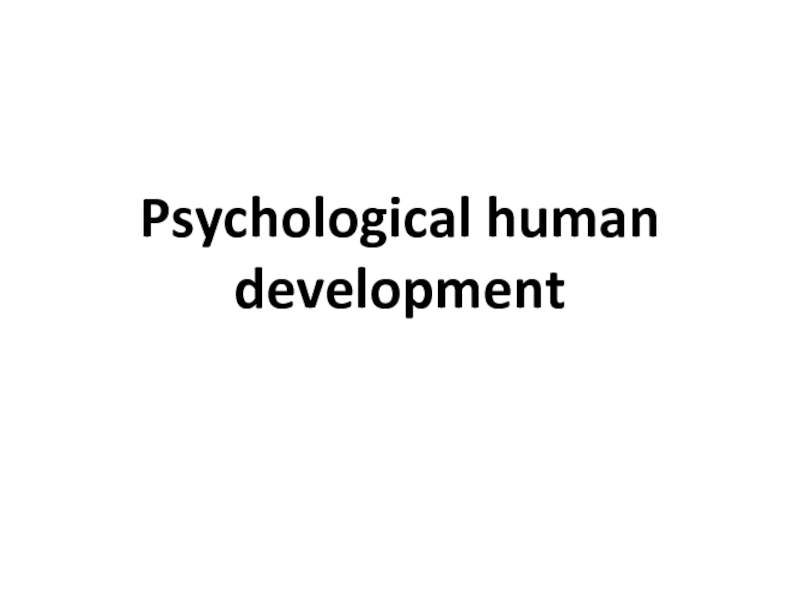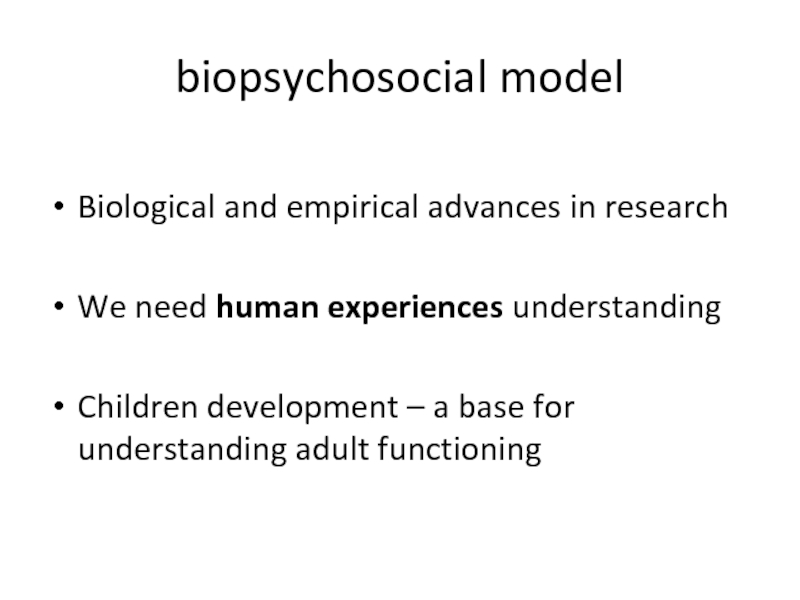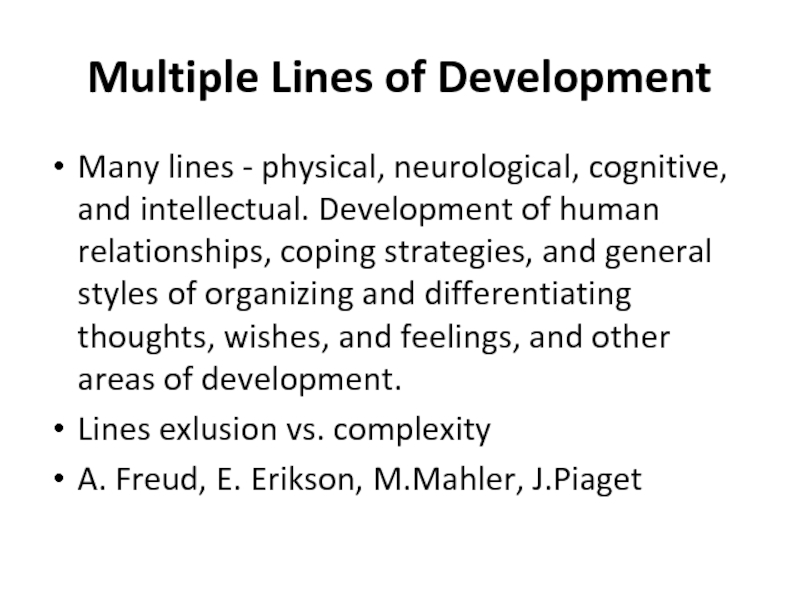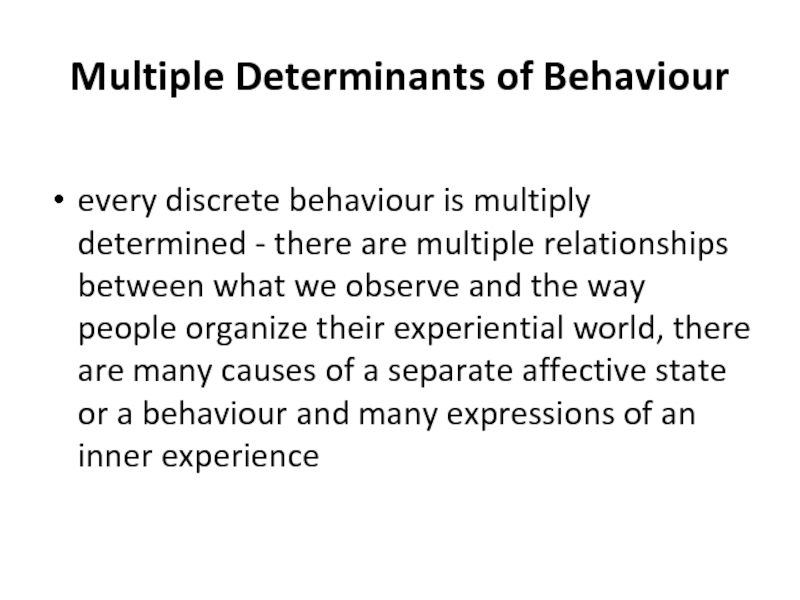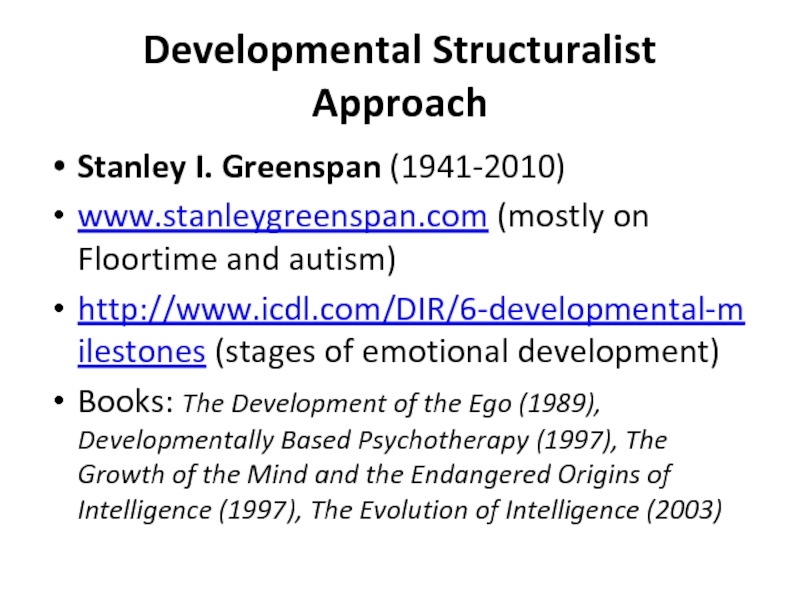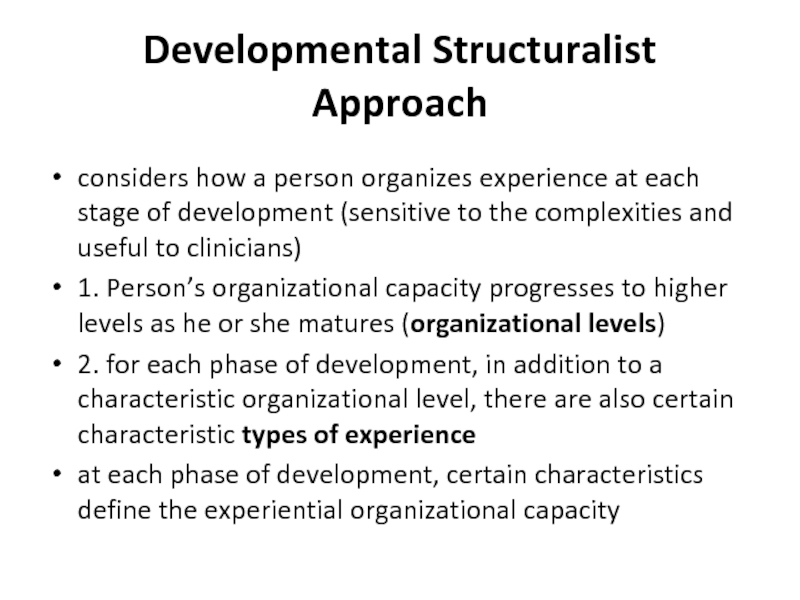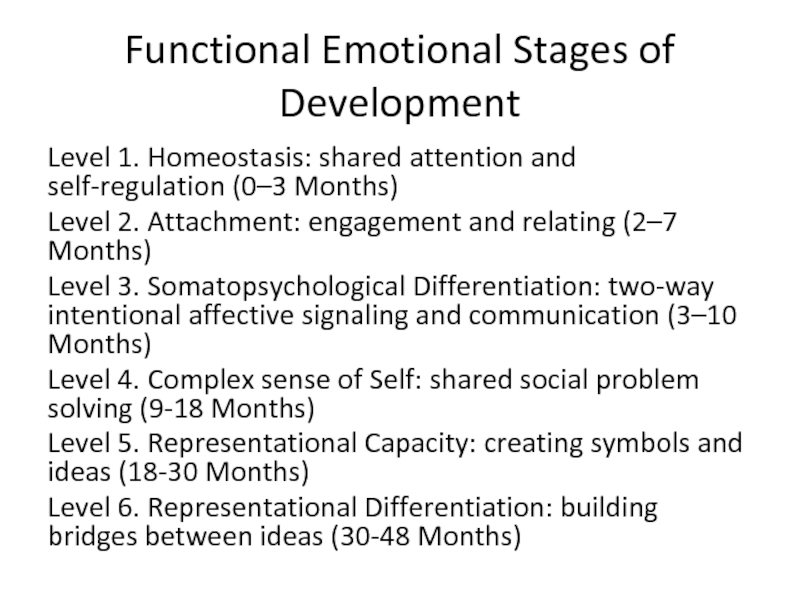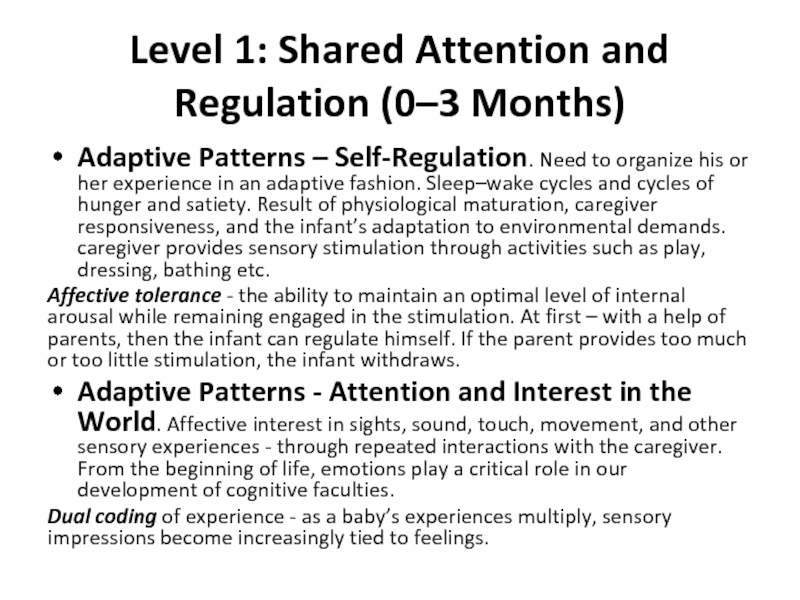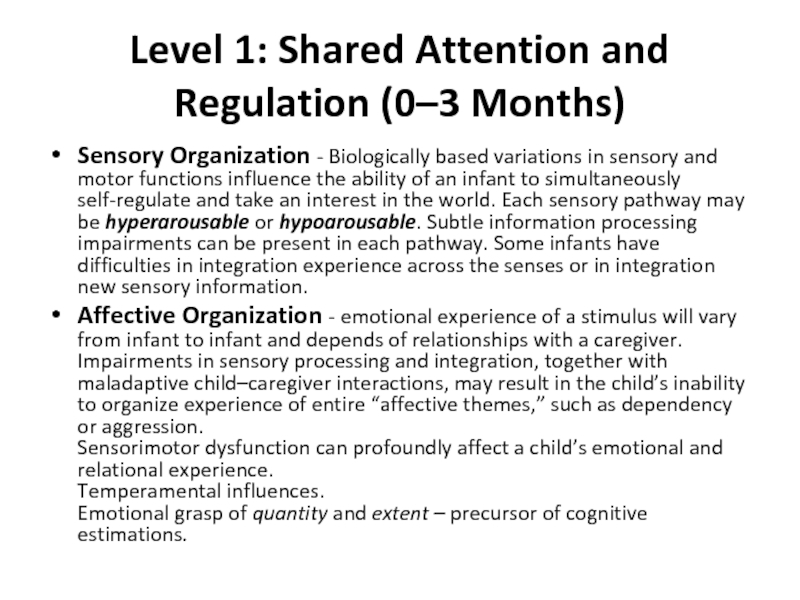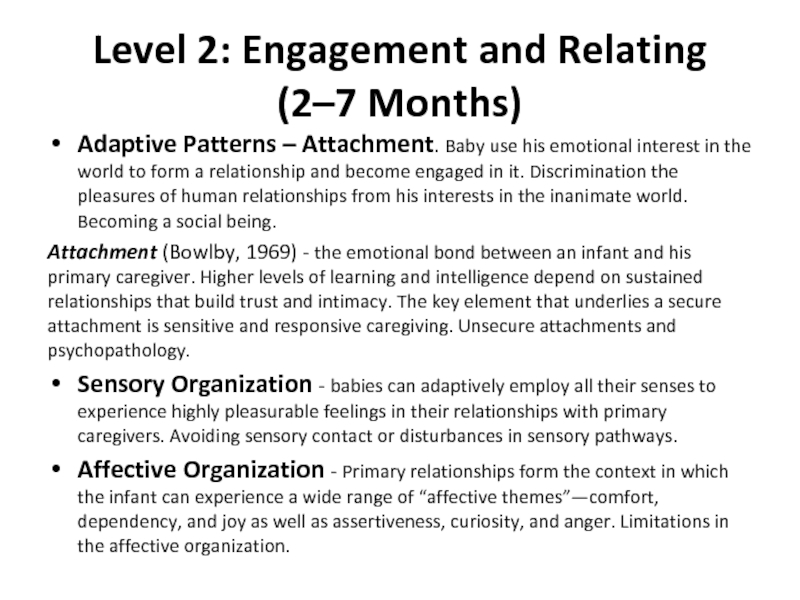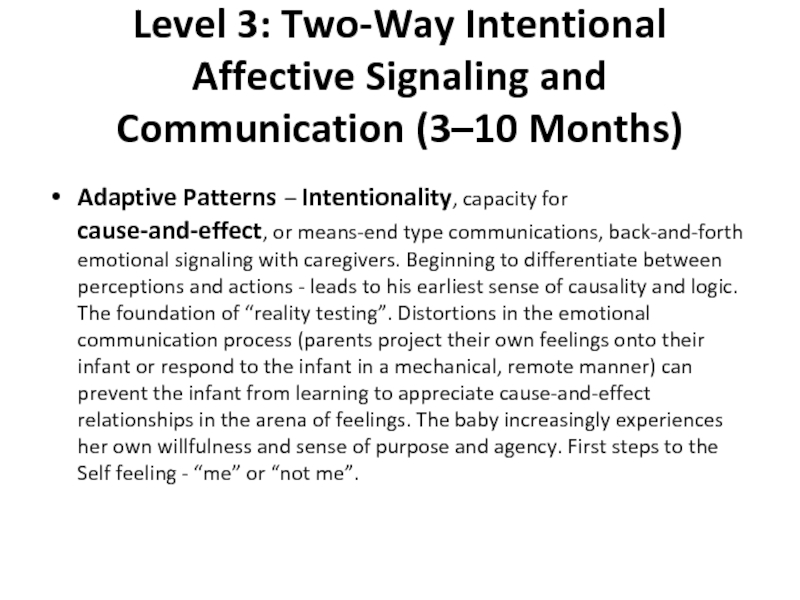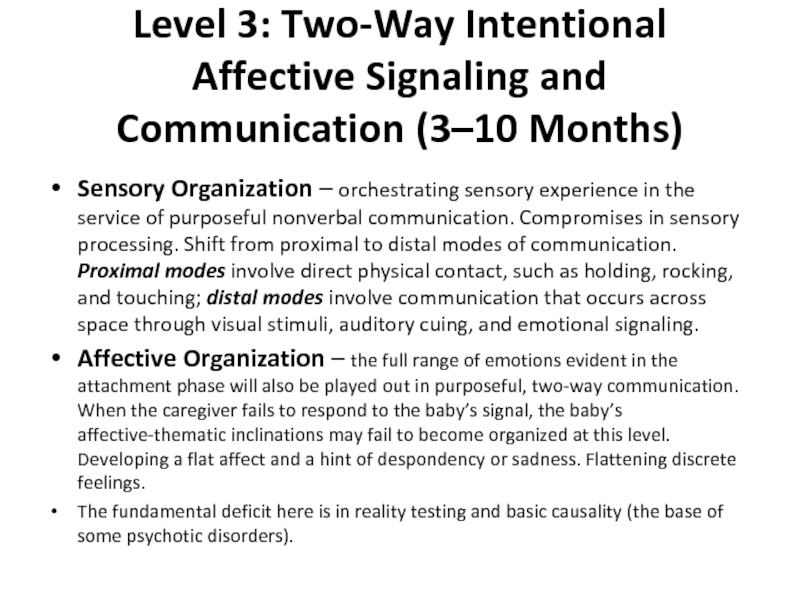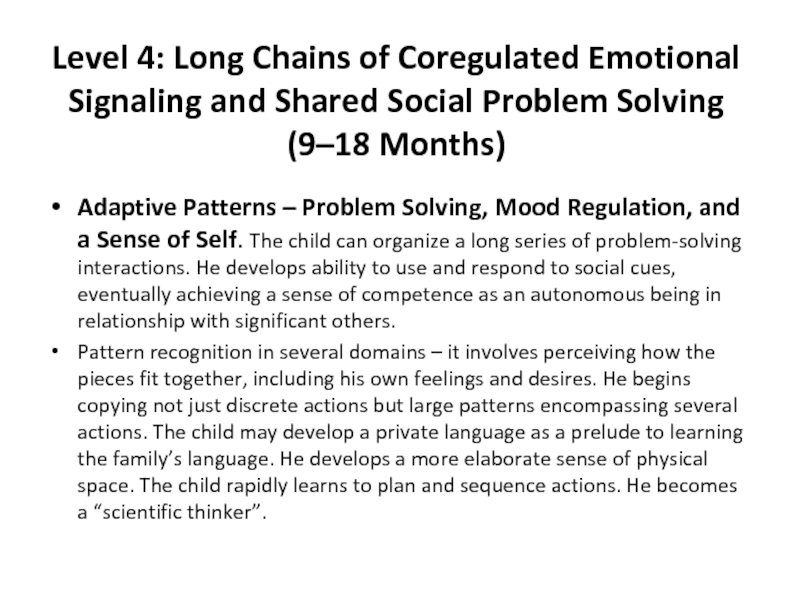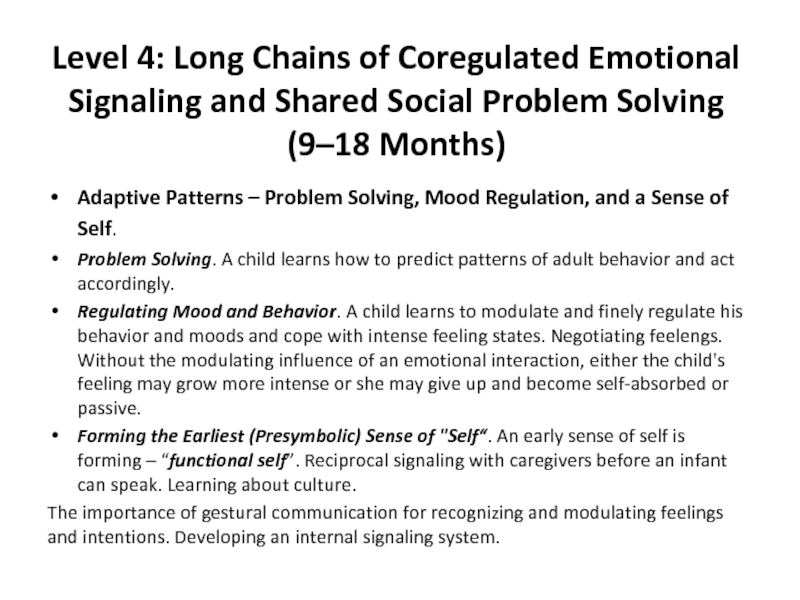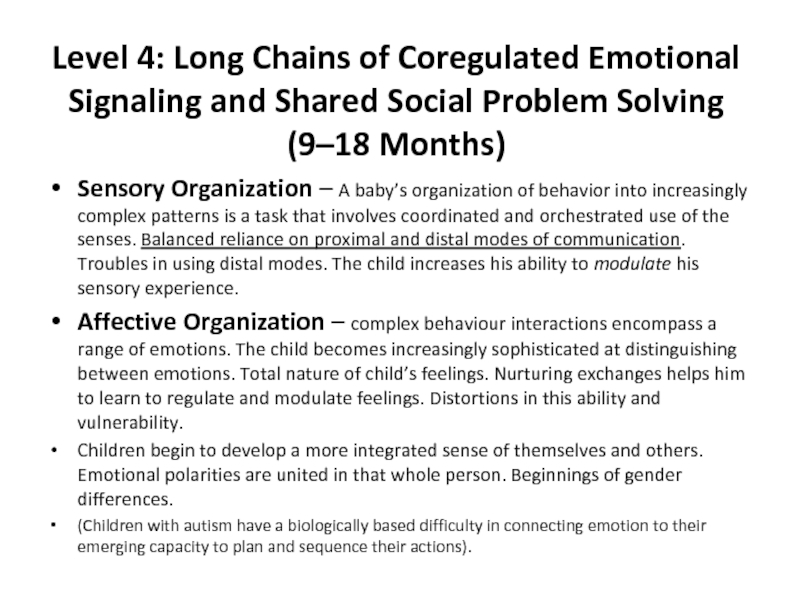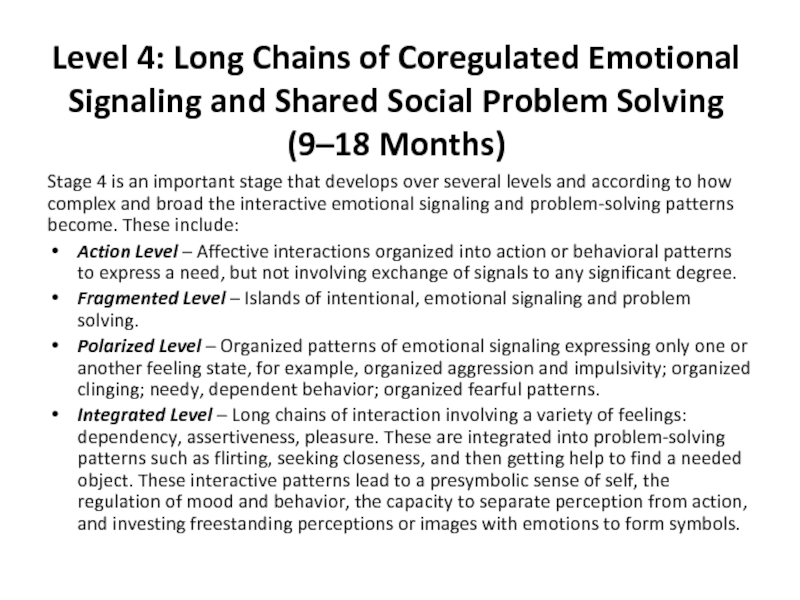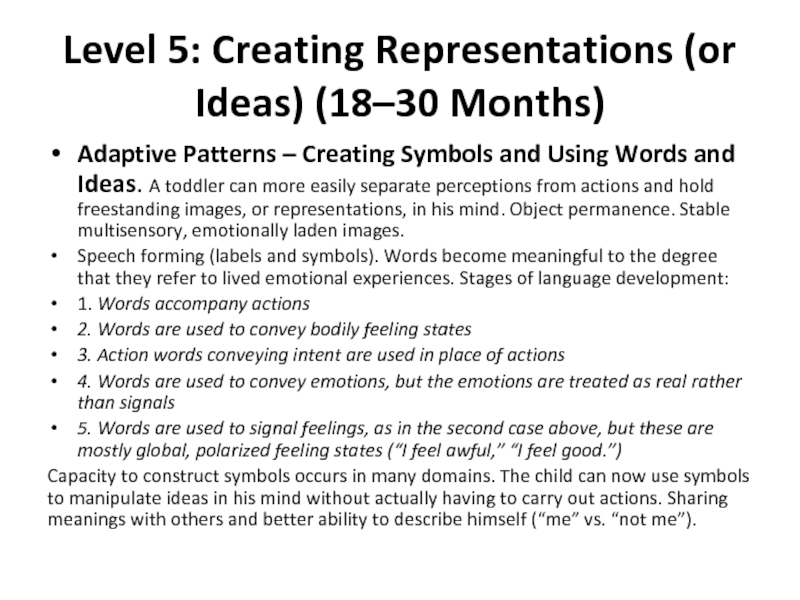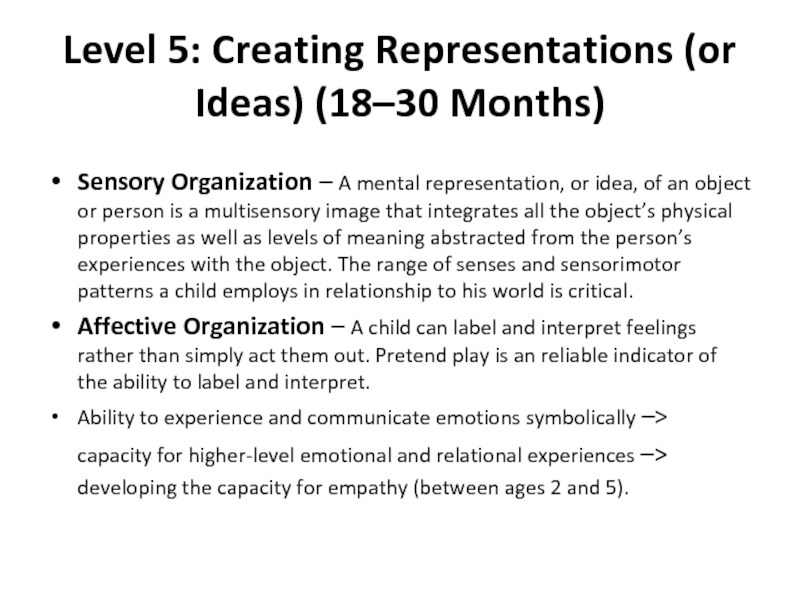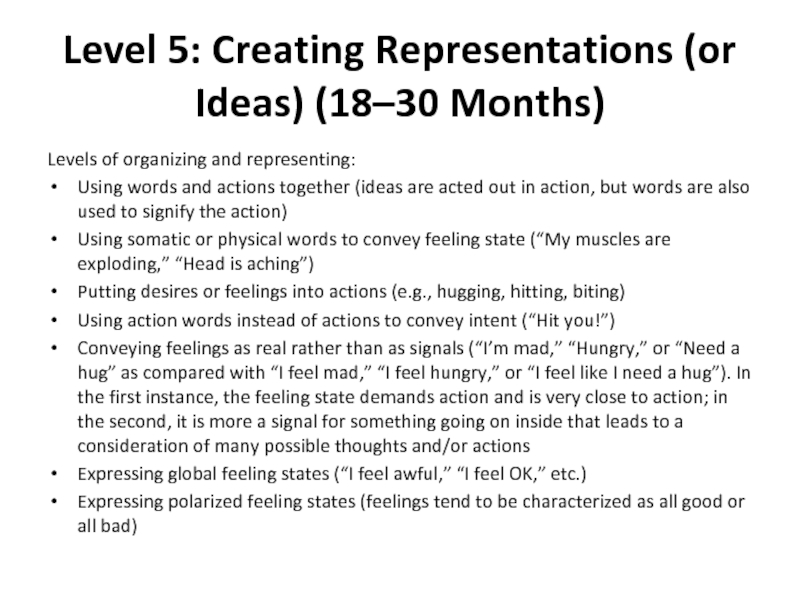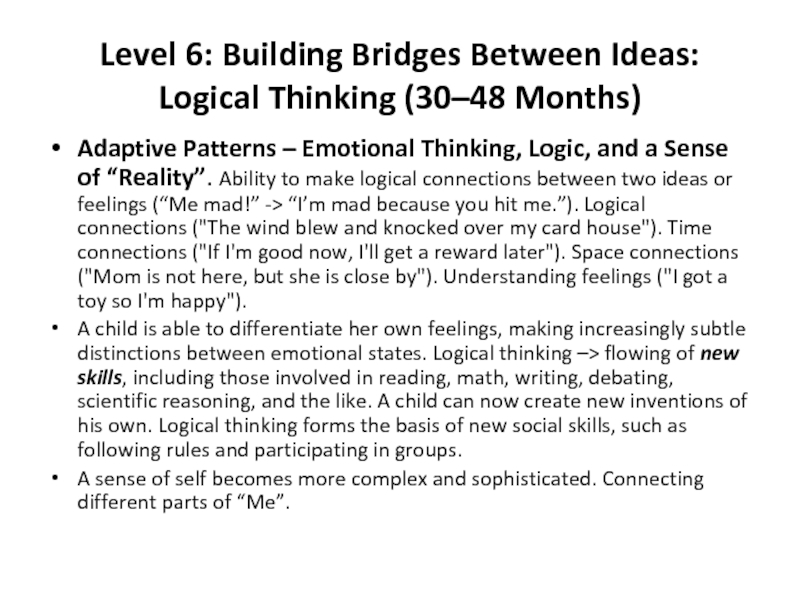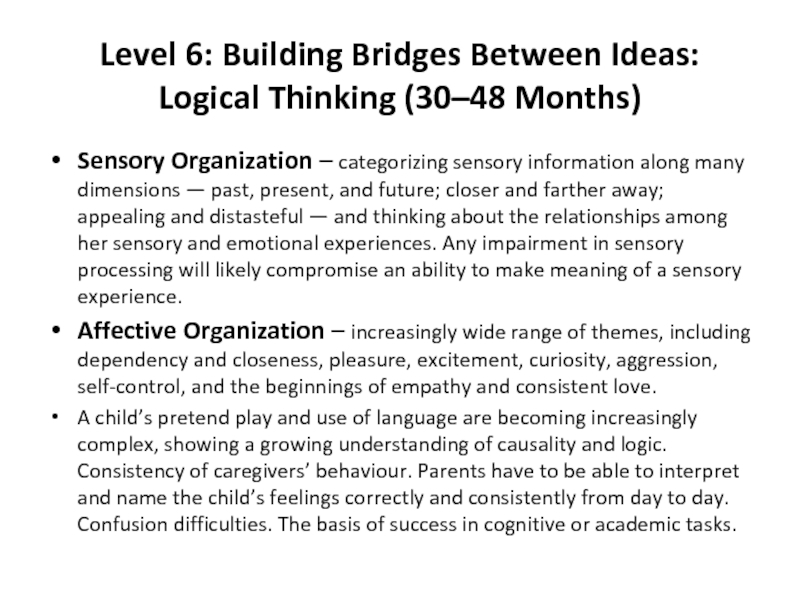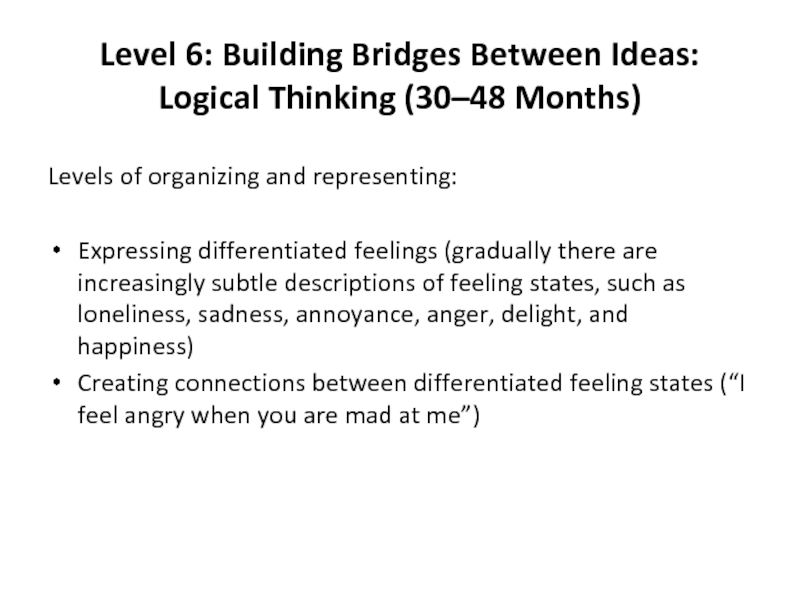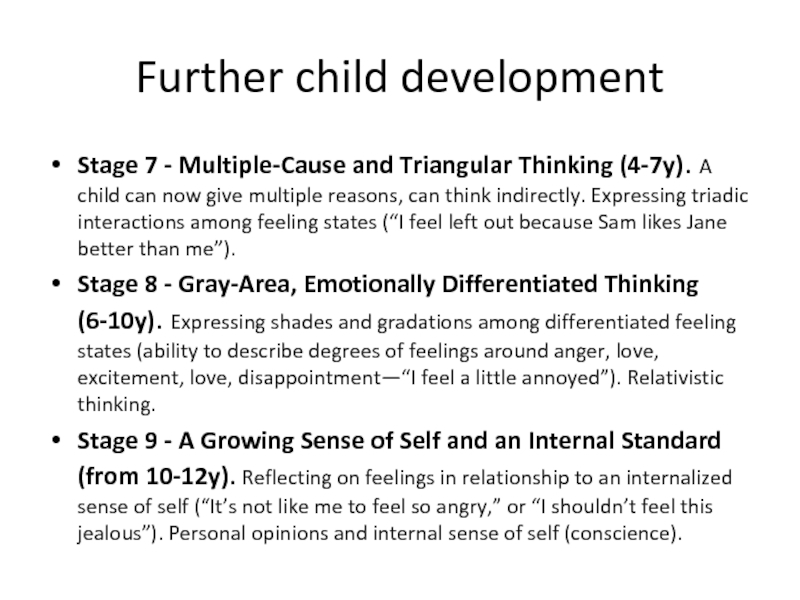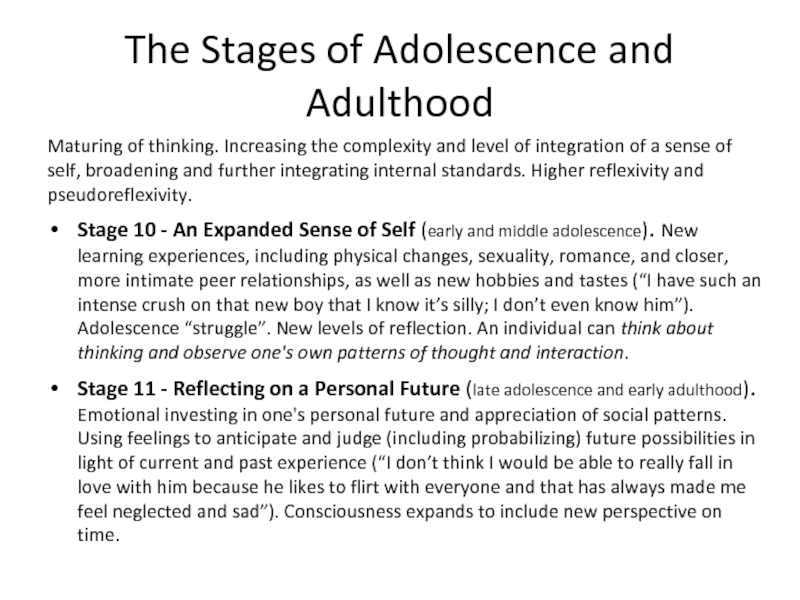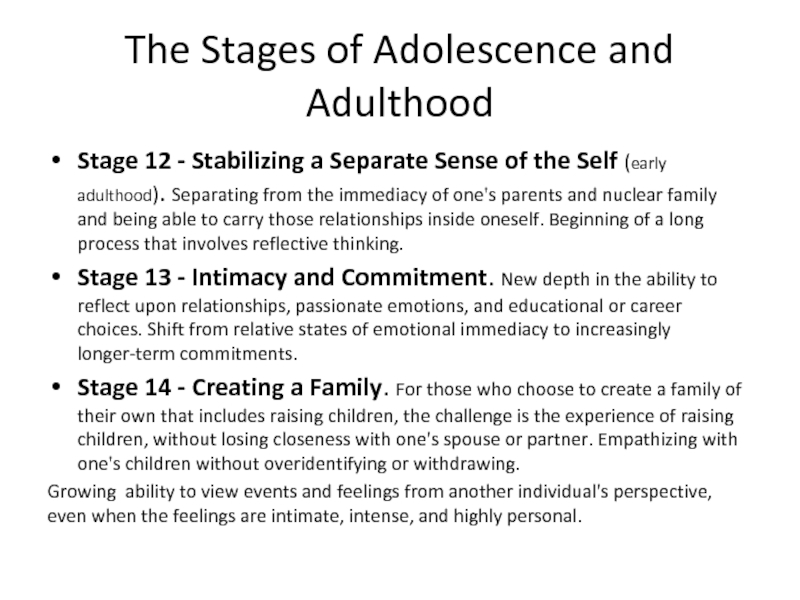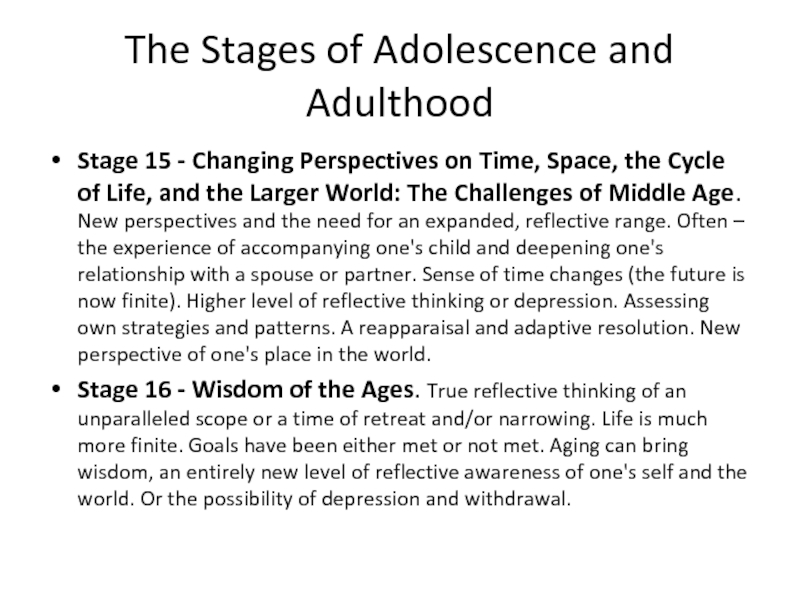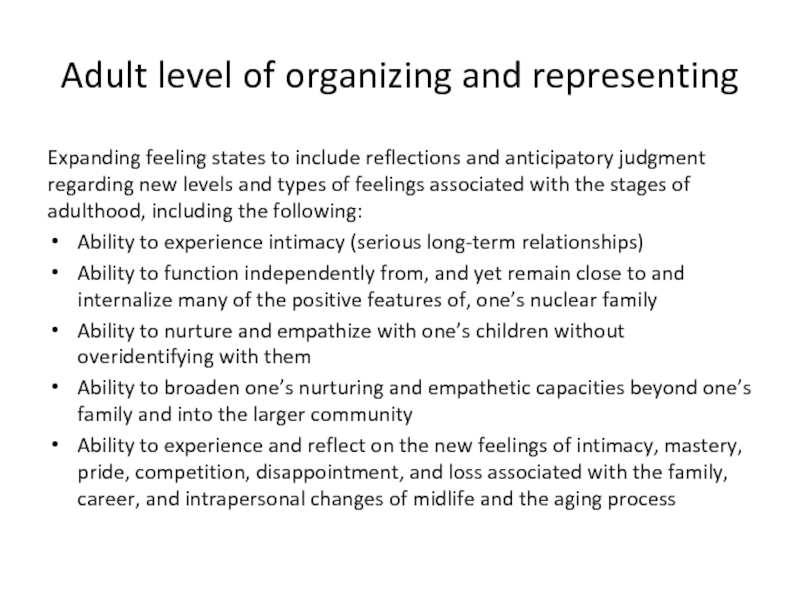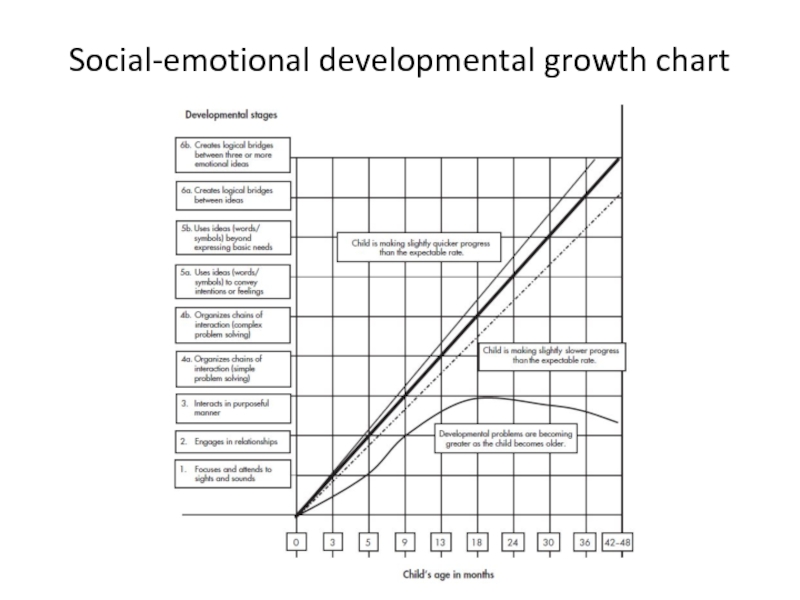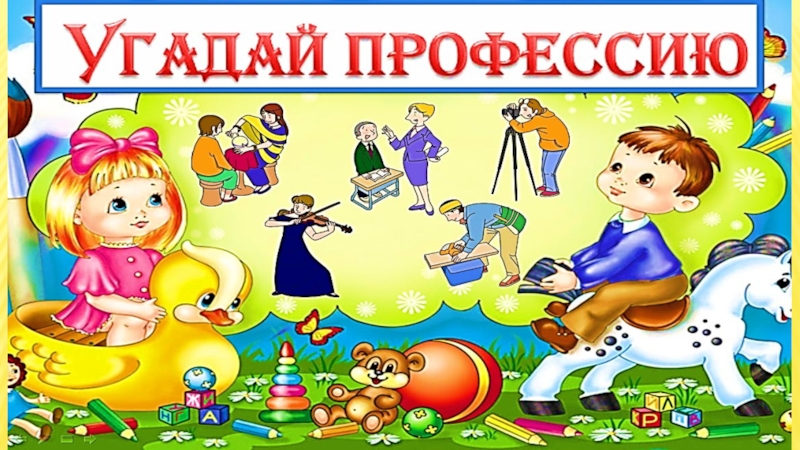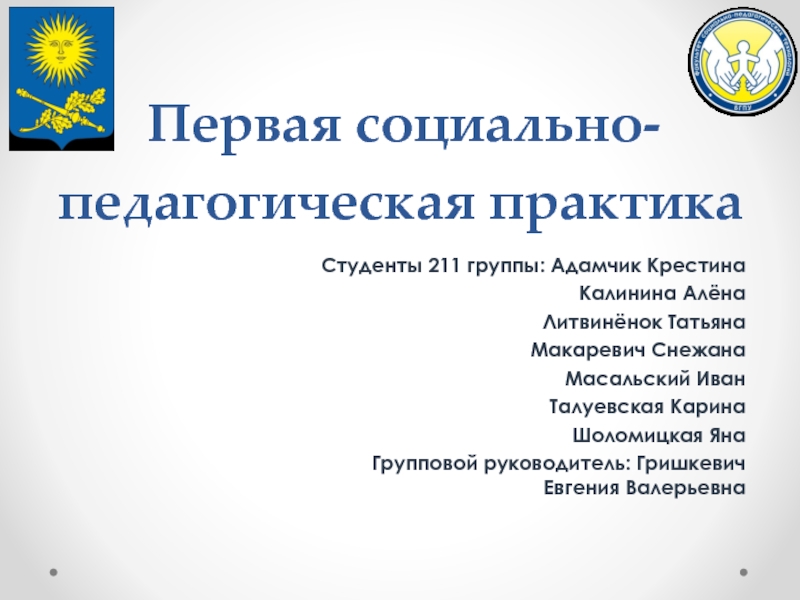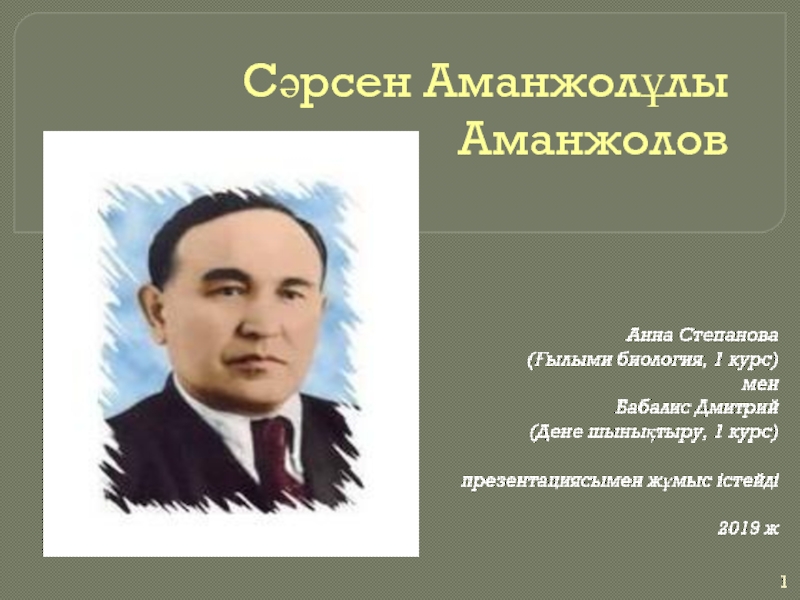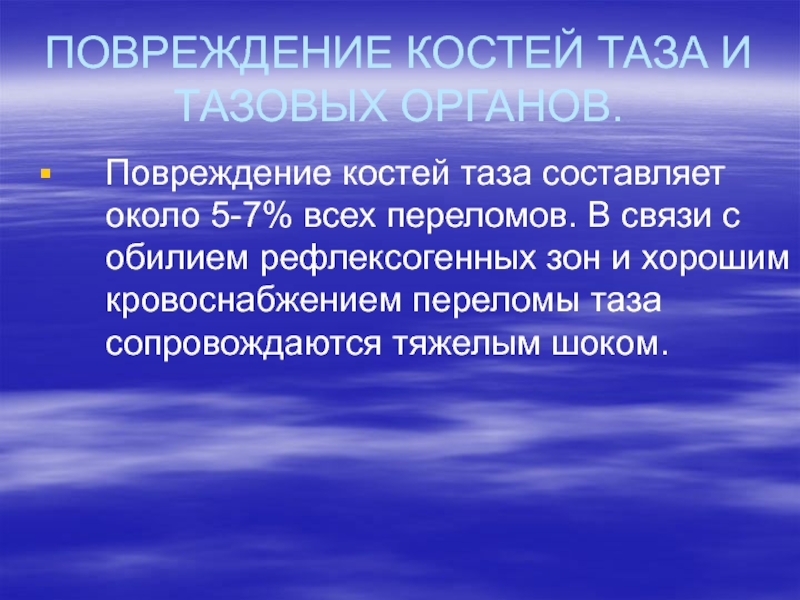Разделы презентаций
- Разное
- Английский язык
- Астрономия
- Алгебра
- Биология
- География
- Геометрия
- Детские презентации
- Информатика
- История
- Литература
- Математика
- Медицина
- Менеджмент
- Музыка
- МХК
- Немецкий язык
- ОБЖ
- Обществознание
- Окружающий мир
- Педагогика
- Русский язык
- Технология
- Физика
- Философия
- Химия
- Шаблоны, картинки для презентаций
- Экология
- Экономика
- Юриспруденция
Psychological human development
Содержание
- 1. Psychological human development
- 2. biopsychosocial modelBiological and empirical advances in researchWe
- 3. Multiple Lines of DevelopmentMany lines - physical,
- 4. Multiple Determinants of Behaviourevery discrete behaviour is
- 5. Developmental Structuralist ApproachStanley I. Greenspan (1941-2010)www.stanleygreenspan.com (mostly
- 6. Developmental Structuralist Approachconsiders how a person organizes
- 7. Functional Emotional Stages of DevelopmentLevel 1. Homeostasis:
- 8. Level 1: Shared Attention and Regulation (0–3
- 9. Level 1: Shared Attention and Regulation (0–3
- 10. Level 2: Engagement and Relating (2–7 Months)Adaptive
- 11. Level 3: Two-Way Intentional Affective Signaling and
- 12. Level 3: Two-Way Intentional Affective Signaling and
- 13. Level 4: Long Chains of Coregulated Emotional
- 14. Level 4: Long Chains of Coregulated Emotional
- 15. Level 4: Long Chains of Coregulated Emotional
- 16. Level 4: Long Chains of Coregulated Emotional
- 17. Level 5: Creating Representations (or Ideas) (18–30
- 18. Level 5: Creating Representations (or Ideas) (18–30
- 19. Level 5: Creating Representations (or Ideas) (18–30
- 20. Level 6: Building Bridges Between Ideas: Logical
- 21. Level 6: Building Bridges Between Ideas: Logical
- 22. Level 6: Building Bridges Between Ideas: Logical
- 23. Further child developmentStage 7 - Multiple-Cause and
- 24. The Stages of Adolescence and AdulthoodMaturing of
- 25. The Stages of Adolescence and AdulthoodStage 12
- 26. The Stages of Adolescence and AdulthoodStage 15
- 27. Adult level of organizing and representingExpanding feeling
- 28. Social-emotional developmental growth chart
- 29. Скачать презентанцию
biopsychosocial modelBiological and empirical advances in researchWe need human experiences understandingChildren development – a base for understanding adult functioning
Слайды и текст этой презентации
Слайд 2biopsychosocial model
Biological and empirical advances in research
We need human experiences
understanding
Слайд 3Multiple Lines of Development
Many lines - physical, neurological, cognitive, and
intellectual. Development of human relationships, coping strategies, and general styles
of organizing and differentiating thoughts, wishes, and feelings, and other areas of development.Lines exlusion vs. complexity
A. Freud, E. Erikson, M.Mahler, J.Piaget
Слайд 4Multiple Determinants of Behaviour
every discrete behaviour is multiply determined -
there are multiple relationships between what we observe and the
way people organize their experiential world, there are many causes of a separate affective state or a behaviour and many expressions of an inner experienceСлайд 5Developmental Structuralist
Approach
Stanley I. Greenspan (1941-2010)
www.stanleygreenspan.com (mostly on Floortime and autism)
http://www.icdl.com/DIR/6-developmental-milestones
(stages of emotional development)
Books: The Development of the Ego (1989),
Developmentally Based Psychotherapy (1997), The Growth of the Mind and the Endangered Origins of Intelligence (1997 ), The Evolution of Intelligence (2003)Слайд 6Developmental Structuralist
Approach
considers how a person organizes experience at each stage
of development (sensitive to the complexities and useful to clinicians)
1.
Person’s organizational capacity progresses to higher levels as he or she matures (organizational levels)2. for each phase of development, in addition to a characteristic organizational level, there are also certain characteristic types of experience
at each phase of development, certain characteristics define the experiential organizational capacity
Слайд 7Functional Emotional Stages of
Development
Level 1. Homeostasis: shared attention and self-regulation
(0–3 Months)
Level 2. Attachment: engagement and relating (2–7 Months)
Level 3.
Somatopsychological Differentiation: two-way intentional affective signaling and communication (3–10 Months)Level 4. Complex sense of Self: shared social problem solving (9-18 Months)
Level 5. Representational Capacity: creating symbols and ideas (18-30 Months)
Level 6. Representational Differentiation: building bridges between ideas (30-48 Months)
Слайд 8Level 1: Shared Attention and Regulation (0–3 Months)
Adaptive Patterns –
Self-Regulation. Need to organize his or her experience in an
adaptive fashion. Sleep–wake cycles and cycles of hunger and satiety. Result of physiological maturation, caregiver responsiveness, and the infant’s adaptation to environmental demands. caregiver provides sensory stimulation through activities such as play, dressing, bathing etc.Affective tolerance - the ability to maintain an optimal level of internal arousal while remaining engaged in the stimulation. At first – with a help of parents, then the infant can regulate himself. If the parent provides too much or too little stimulation, the infant withdraws.
Adaptive Patterns - Attention and Interest in the World. Affective interest in sights, sound, touch, movement, and other sensory experiences - through repeated interactions with the caregiver. From the beginning of life, emotions play a critical role in our development of cognitive faculties.
Dual coding of experience - as a baby’s experiences multiply, sensory impressions become increasingly tied to feelings.
Слайд 9Level 1: Shared Attention and Regulation (0–3 Months)
Sensory Organization -
Biologically based variations in sensory and motor functions influence the
ability of an infant to simultaneously self-regulate and take an interest in the world. Each sensory pathway may be hyperarousable or hypoarousable. Subtle information processing impairments can be present in each pathway. Some infants have difficulties in integration experience across the senses or in integration new sensory information.Affective Organization - emotional experience of a stimulus will vary from infant to infant and depends of relationships with a caregiver. Impairments in sensory processing and integration, together with maladaptive child–caregiver interactions, may result in the child’s inability to organize experience of entire “affective themes,” such as dependency or aggression. Sensorimotor dysfunction can profoundly affect a child’s emotional and relational experience. Temperamental influences. Emotional grasp of quantity and extent – precursor of cognitive estimations.
Слайд 10Level 2: Engagement and Relating
(2–7 Months)
Adaptive Patterns – Attachment. Baby
use his emotional interest in the world to form a
relationship and become engaged in it. Discrimination the pleasures of human relationships from his interests in the inanimate world. Becoming a social being.Attachment (Bowlby, 1969) - the emotional bond between an infant and his primary caregiver. Higher levels of learning and intelligence depend on sustained relationships that build trust and intimacy. The key element that underlies a secure attachment is sensitive and responsive caregiving. Unsecure attachments and psychopathology.
Sensory Organization - babies can adaptively employ all their senses to experience highly pleasurable feelings in their relationships with primary caregivers. Avoiding sensory contact or disturbances in sensory pathways.
Affective Organization - Primary relationships form the context in which the infant can experience a wide range of “affective themes”—comfort, dependency, and joy as well as assertiveness, curiosity, and anger. Limitations in the affective organization.
Слайд 11Level 3: Two-Way Intentional Affective Signaling and Communication (3–10 Months)
Adaptive
Patterns – Intentionality, capacity for cause-and-effect, or means-end type communications,
back-and-forth emotional signaling with caregivers. Beginning to differentiate between perceptions and actions - leads to his earliest sense of causality and logic. The foundation of “reality testing”. Distortions in the emotional communication process (parents project their own feelings onto their infant or respond to the infant in a mechanical, remote manner) can prevent the infant from learning to appreciate cause-and-effect relationships in the arena of feelings. The baby increasingly experiences her own willfulness and sense of purpose and agency. First steps to the Self feeling - “me” or “not me”.Слайд 12Level 3: Two-Way Intentional Affective Signaling and Communication (3–10 Months)
Sensory
Organization – orchestrating sensory experience in the service of purposeful
nonverbal communication. Compromises in sensory processing. Shift from proximal to distal modes of communication. Proximal modes involve direct physical contact, such as holding, rocking, and touching; distal modes involve communication that occurs across space through visual stimuli, auditory cuing, and emotional signaling.Affective Organization – the full range of emotions evident in the attachment phase will also be played out in purposeful, two-way communication. When the caregiver fails to respond to the baby’s signal, the baby’s affective-thematic inclinations may fail to become organized at this level. Developing a flat affect and a hint of despondency or sadness. Flattening discrete feelings.
The fundamental deficit here is in reality testing and basic causality (the base of some psychotic disorders).
Слайд 13Level 4: Long Chains of Coregulated Emotional Signaling and Shared
Social Problem Solving (9–18 Months)
Adaptive Patterns – Problem Solving, Mood
Regulation, and a Sense of Self. The child can organize a long series of problem-solving interactions. He develops ability to use and respond to social cues, eventually achieving a sense of competence as an autonomous being in relationship with significant others. Pattern recognition in several domains – it involves perceiving how the pieces fit together, including his own feelings and desires. He begins copying not just discrete actions but large patterns encompassing several actions. The child may develop a private language as a prelude to learning the family’s language. He develops a more elaborate sense of physical space. The child rapidly learns to plan and sequence actions. He becomes a “scientific thinker”.
Слайд 14Level 4: Long Chains of Coregulated Emotional Signaling and Shared
Social Problem Solving (9–18 Months)
Adaptive Patterns – Problem Solving, Mood
Regulation, and a Sense of Self. Problem Solving. A child learns how to predict patterns of adult behavior and act accordingly.
Regulating Mood and Behavior. A child learns to modulate and finely regulate his behavior and moods and cope with intense feeling states. Negotiating feelengs. Without the modulating influence of an emotional interaction, either the child's feeling may grow more intense or she may give up and become self-absorbed or passive.
Forming the Earliest (Presymbolic) Sense of "Self“. An early sense of self is forming – “functional self”. Reciprocal signaling with caregivers before an infant can speak. Learning about culture.
The importance of gestural communication for recognizing and modulating feelings and intentions. Developing an internal signaling system.
Слайд 15Level 4: Long Chains of Coregulated Emotional Signaling and Shared
Social Problem Solving (9–18 Months)
Sensory Organization – A baby’s organization
of behavior into increasingly complex patterns is a task that involves coordinated and orchestrated use of the senses. Balanced reliance on proximal and distal modes of communication. Troubles in using distal modes. The child increases his ability to modulate his sensory experience.Affective Organization – complex behaviour interactions encompass a range of emotions. The child becomes increasingly sophisticated at distinguishing between emotions. Total nature of child’s feelings. Nurturing exchanges helps him to learn to regulate and modulate feelings. Distortions in this ability and vulnerability.
Children begin to develop a more integrated sense of themselves and others. Emotional polarities are united in that whole person. Beginnings of gender differences.
(Children with autism have a biologically based difficulty in connecting emotion to their emerging capacity to plan and sequence their actions).
Слайд 16Level 4: Long Chains of Coregulated Emotional Signaling and Shared
Social Problem Solving (9–18 Months)
Stage 4 is an important stage
that develops over several levels and according to how complex and broad the interactive emotional signaling and problem-solving patterns become. These include:Action Level – Affective interactions organized into action or behavioral patterns to express a need, but not involving exchange of signals to any significant degree.
Fragmented Level – Islands of intentional, emotional signaling and problem solving.
Polarized Level – Organized patterns of emotional signaling expressing only one or another feeling state, for example, organized aggression and impulsivity; organized clinging; needy, dependent behavior; organized fearful patterns.
Integrated Level – Long chains of interaction involving a variety of feelings: dependency, assertiveness, pleasure. These are integrated into problem-solving patterns such as flirting, seeking closeness, and then getting help to find a needed object. These interactive patterns lead to a presymbolic sense of self, the regulation of mood and behavior, the capacity to separate perception from action, and investing freestanding perceptions or images with emotions to form symbols.
Слайд 17Level 5: Creating Representations (or Ideas) (18–30 Months)
Adaptive Patterns –
Creating Symbols and Using Words and Ideas. A toddler can
more easily separate perceptions from actions and hold freestanding images, or representations, in his mind. Object permanence. Stable multisensory, emotionally laden images.Speech forming (labels and symbols). Words become meaningful to the degree that they refer to lived emotional experiences. Stages of language development:
1. Words accompany actions
2. Words are used to convey bodily feeling states
3. Action words conveying intent are used in place of actions
4. Words are used to convey emotions, but the emotions are treated as real rather than signals
5. Words are used to signal feelings, as in the second case above, but these are mostly global, polarized feeling states (“I feel awful,” “I feel good.”)
Capacity to construct symbols occurs in many domains. The child can now use symbols to manipulate ideas in his mind without actually having to carry out actions. Sharing meanings with others and better ability to describe himself (“me” vs. “not me”).
Слайд 18Level 5: Creating Representations (or Ideas) (18–30 Months)
Sensory Organization –
A mental representation, or idea, of an object or person
is a multisensory image that integrates all the object’s physical properties as well as levels of meaning abstracted from the person’s experiences with the object. The range of senses and sensorimotor patterns a child employs in relationship to his world is critical.Affective Organization – A child can label and interpret feelings rather than simply act them out. Pretend play is an reliable indicator of the ability to label and interpret.
Ability to experience and communicate emotions symbolically –>
capacity for higher-level emotional and relational experiences –>
developing the capacity for empathy (between ages 2 and 5).
Слайд 19Level 5: Creating Representations (or Ideas) (18–30 Months)
Levels of organizing
and representing:
Using words and actions together (ideas are acted out
in action, but words are also used to signify the action)Using somatic or physical words to convey feeling state (“My muscles are exploding,” “Head is aching”)
Putting desires or feelings into actions (e.g., hugging, hitting, biting)
Using action words instead of actions to convey intent (“Hit you!”)
Conveying feelings as real rather than as signals (“I’m mad,” “Hungry,” or “Need a hug” as compared with “I feel mad,” “I feel hungry,” or “I feel like I need a hug”). In the first instance, the feeling state demands action and is very close to action; in the second, it is more a signal for something going on inside that leads to a consideration of many possible thoughts and/or actions
Expressing global feeling states (“I feel awful,” “I feel OK,” etc.)
Expressing polarized feeling states (feelings tend to be characterized as all good or all bad)
Слайд 20Level 6: Building Bridges Between Ideas: Logical Thinking (30–48 Months)
Adaptive
Patterns – Emotional Thinking, Logic, and a Sense of “Reality”.
Ability to make logical connections between two ideas or feelings (“Me mad!” -> “I’m mad because you hit me.”). Logical connections ("The wind blew and knocked over my card house"). Time connections ("If I'm good now, I'll get a reward later"). Space connections ("Mom is not here, but she is close by"). Understanding feelings ("I got a toy so I'm happy").A child is able to differentiate her own feelings, making increasingly subtle distinctions between emotional states. Logical thinking –> flowing of new skills, including those involved in reading, math, writing, debating, scientific reasoning, and the like. A child can now create new inventions of his own. Logical thinking forms the basis of new social skills, such as following rules and participating in groups.
A sense of self becomes more complex and sophisticated. Connecting different parts of “Me”.
Слайд 21Level 6: Building Bridges Between Ideas: Logical Thinking (30–48 Months)
Sensory
Organization – categorizing sensory information along many dimensions — past,
present, and future; closer and farther away; appealing and distasteful — and thinking about the relationships among her sensory and emotional experiences. Any impairment in sensory processing will likely compromise an ability to make meaning of a sensory experience.Affective Organization – increasingly wide range of themes, including dependency and closeness, pleasure, excitement, curiosity, aggression, self-control, and the beginnings of empathy and consistent love.
A child’s pretend play and use of language are becoming increasingly complex, showing a growing understanding of causality and logic. Consistency of caregivers’ behaviour. Parents have to be able to interpret and name the child’s feelings correctly and consistently from day to day. Confusion difficulties. The basis of success in cognitive or academic tasks.
Слайд 22Level 6: Building Bridges Between Ideas: Logical Thinking (30–48 Months)
Levels
of organizing and representing:
Expressing differentiated feelings (gradually there are increasingly
subtle descriptions of feeling states, such as loneliness, sadness, annoyance, anger, delight, and happiness)Creating connections between differentiated feeling states (“I feel angry when you are mad at me”)
Слайд 23Further child development
Stage 7 - Multiple-Cause and Triangular Thinking (4-7y).
A child can now give multiple reasons, can think indirectly.
Expressing triadic interactions among feeling states (“I feel left out because Sam likes Jane better than me”).Stage 8 - Gray-Area, Emotionally Differentiated Thinking (6-10y). Expressing shades and gradations among differentiated feeling states (ability to describe degrees of feelings around anger, love, excitement, love, disappointment—“I feel a little annoyed”). Relativistic thinking.
Stage 9 - A Growing Sense of Self and an Internal Standard (from 10-12y). Reflecting on feelings in relationship to an internalized sense of self (“It’s not like me to feel so angry,” or “I shouldn’t feel this jealous”). Personal opinions and internal sense of self (conscience).
Слайд 24The Stages of Adolescence and Adulthood
Maturing of thinking. Increasing the
complexity and level of integration of a sense of self,
broadening and further integrating internal standards. Higher reflexivity and pseudoreflexivity.Stage 10 - An Expanded Sense of Self (early and middle adolescence). New learning experiences, including physical changes, sexuality, romance, and closer, more intimate peer relationships, as well as new hobbies and tastes (“I have such an intense crush on that new boy that I know it’s silly; I don’t even know him”). Adolescence “struggle”. New levels of reflection. An individual can think about thinking and observe one's own patterns of thought and interaction.
Stage 11 - Reflecting on a Personal Future (late adolescence and early adulthood). Emotional investing in one's personal future and appreciation of social patterns. Using feelings to anticipate and judge (including probabilizing) future possibilities in light of current and past experience (“I don’t think I would be able to really fall in love with him because he likes to flirt with everyone and that has always made me feel neglected and sad”). Consciousness expands to include new perspective on time.
Слайд 25The Stages of Adolescence and Adulthood
Stage 12 - Stabilizing a
Separate Sense of the Self (early adulthood). Separating from the
immediacy of one's parents and nuclear family and being able to carry those relationships inside oneself. Beginning of a long process that involves reflective thinking.Stage 13 - Intimacy and Commitment. New depth in the ability to reflect upon relationships, passionate emotions, and educational or career choices. Shift from relative states of emotional immediacy to increasingly longer-term commitments.
Stage 14 - Creating a Family. For those who choose to create a family of their own that includes raising children, the challenge is the experience of raising children, without losing closeness with one's spouse or partner. Empathizing with one's children without overidentifying or withdrawing.
Growing ability to view events and feelings from another individual's perspective, even when the feelings are intimate, intense, and highly personal.
Слайд 26The Stages of Adolescence and Adulthood
Stage 15 - Changing Perspectives
on Time, Space, the Cycle of Life, and the Larger
World: The Challenges of Middle Age. New perspectives and the need for an expanded, reflective range. Often – the experience of accompanying one's child and deepening one's relationship with a spouse or partner. Sense of time changes (the future is now finite). Higher level of reflective thinking or depression. Assessing own strategies and patterns. A reapparaisal and adaptive resolution. New perspective of one's place in the world.Stage 16 - Wisdom of the Ages. True reflective thinking of an unparalleled scope or a time of retreat and/or narrowing. Life is much more finite. Goals have been either met or not met. Aging can bring wisdom, an entirely new level of reflective awareness of one's self and the world. Or the possibility of depression and withdrawal.
Слайд 27Adult level of organizing and representing
Expanding feeling states to include
reflections and anticipatory judgment regarding new levels and types of
feelings associated with the stages of adulthood, including the following:Ability to experience intimacy (serious long-term relationships)
Ability to function independently from, and yet remain close to and internalize many of the positive features of, one’s nuclear family
Ability to nurture and empathize with one’s children without overidentifying with them
Ability to broaden one’s nurturing and empathetic capacities beyond one’s family and into the larger community
Ability to experience and reflect on the new feelings of intimacy, mastery, pride, competition, disappointment, and loss associated with the family, career, and intrapersonal changes of midlife and the aging process
